Introduction:
In 1857 Cyrus Field made his first attempt to lay the Atlantic Cable
from Ireland to Newfoundland. The full length of the cable could
not be accommodated in a single ship, so the plan was to begin laying
from Ireland with the American Navy’s steam frigate USS Niagara,
then in mid-ocean splice to cable carried on the British Admiralty’s
HMS Agamemnon, which would complete the run to Newfoundland.
Accompanied
by other support ships, the cable fleet assembled at the beginning
of August 1857 in Doulus Bay at Valentia Island off the south west
coast of Ireland and prepared to land the shore end of the cable.
This
portfolio of eight tinted lithographs showing the landing of the
shore end of the 1857 Atlantic cable was drawn and printed by John
R. Isaac in 1857, and published by Lloyd Brothers of Liverpool.
The accompanying text describes the activities; an addendum notes
that this expedition was unsuccessful, the cable breaking and the
end being lost after laying 380 nautical miles.
The artist and printer of these lithographs, John Raphael Isaac (1808-1870), lived and worked in Liverpool, England, and produced much nautical material during his career, both his own work and that of others. An 1843 letter
from him to photography pioneer Henry Fox Talbot gives his address
as “Establishment for Designing, Engraving, & Lithography,
Liverpool, 62 Castle St.”, the same address as on the 1857
portfolio. Census records (year unknown) list him as “Draftsman,
Engraver, Lithographer & Printer, employing 9 men” in Liverpool.
A
second text page reproducing the notes of Charles Bright and Cyrus
Field on the 1858 cable expedition was added to the portfolio at
the conclusion of that expedition, but does not note that the 1858
cable failed after a few weeks of intermittent operation. This edition was advertised in the Liverpool Mercury issue of 13 September 1858:
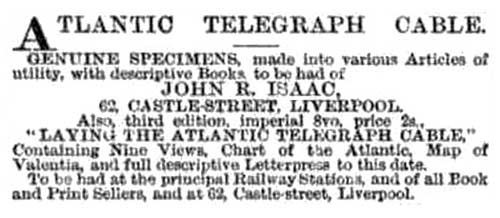
ATLANTIC TELEGRAPH CABLE.
GENUINE SPECIMENS, made into various Articles of utility, with descriptive Books to be had of
JOHN R. ISAAC,
62, CASTLE STREET, LIVERPOOL
Also, third edition, imperial 8vo, prlce 2s.
"LAYING THE ATLANTIC TELEGRAPH CABLE"
Containing Nine Views, Chart of the Atlantic, Map of Valentia, and full descriptive Letterpress to this date.
To be had at the principal Railway Station, and of all Book and Print Sellers, and at 62, Castle-street, Liverpool. |
Although John Isaac’s main occupation was printmaker, he evidently could not resist the promotional aspect of also offering samples of the Atlantic Cable to go with his portfolio of lithographs. Many other enterprising merchants did the same thing.
John R. Isaac is buried in the Deane Road Cemetery in Liverpool; a dedicated group of volunteers completed restoration of the cemetery in 2012, and there was an excellent website on the project, now defunct, which included biographies of notables buried there. James Dickie contributed details of John R. Isaac’s life and career to the biographies section, and that information is reproduced at the end of this article by kind permission of Mr. Dickie.
|
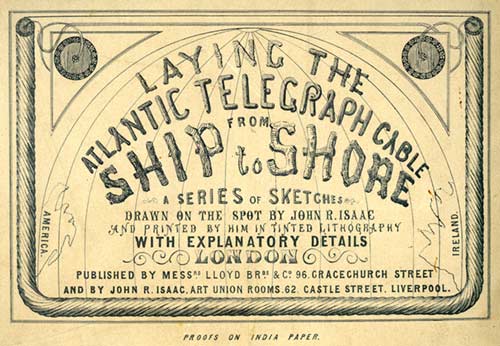 |
LAYING THE
ATLANTIC TELEGRAPH CABLE
FROM
SHIP to SHORE
A SERIES OF SKETCHES
DRAWN ON THE SPOT BY JOHN R. ISAAC
AND PRINTED BY HIM IN TINTED LITHOGRAPHY
WITH EXPLANATORY DETAILS
LONDON
PUBLISHED BY MESSRS LLOYD BROS. & CO.
96, GRACECHURCH STREET
AND BY JOHN R. ISAAC, ART UNION ROOMS, 62, CASTLE STREET, LIVERPOOL.
PROOFS ON INDIA PAPER
| CONTENTS. |
| |
EXPLANATORY DETAILS. |
| PLATE 1. |
MAP OF VALENTIA HARBOUR
AND POSITION OF THE SHIPS. |
| PLATE 2. |
THE SHIPS OF THE SQUADRON.* |
| PLATE 3. |
THE NIAGARA DELIVERING THE SHORE CABLE INTO THE BOATS AND STEAM
TUG “WILLING MIND” |
| PLATE 4. |
PAYING OUT THE CABLE FROM THE DECK OF THE “WILLING MIND,” BOATS
ACTING AS BUOYS. |
| PLATE 5. |
THE “WILLING MIND” AND BOATS WITH CABLE,
TOWED BY H.M. STEAMER “ADVICE” |
| PLATE 6. |
THE CABLE BOATS TOWED INTO SHALLOW WATER BY THE “WILLING MIND.” |
| PLATE 7. |
HAULING THE CABLE ON SHORE
INTO THE TRENCH CUT FOR ITS RECEPTION. |
| PLATE 8. |
DEPARTURE.
THE NIAGARA FOUR MILES OUT. |
| *
1. Cyclops. 2. Agamemnon. 3. Susquehana. 4. Leopard.
5. Advice. 6. Niagara. Willing Mind |
[1857
text]
The
Atlantic Telegraph Cable
Narrative
and Explanatory Details of the Plates
On the morning of
the 5th of August [1857], accompanied by an eminent
Professor, I embarked in a two-oared boat, on an expedition for the purpose
of making short-hand sketches of that interesting operation, laying the
shore cable of the Atlantic Telegraph from the United States steam frigate
“Niagara,” through the harbour of Valencia, a distance of two
miles-and-a-half to the Irish coast. Here, a trench, indicated in Plate
VI., had been cut for its reception, communicating with the temporary
office, from whence eventually a correspondence between the Old World
and the New will be maintained, the future beneficial effects of which
are incalculable.
Astir early in the
morning, we found it blowing somewhat fresh, and an uncertainty prevailed
as to the Cable being then laid; towards ten A.M., however, it cleared
off, and having taken possession of our boat, we rowed for the little
island of Beginnis, situated in the middle of the stream of the North-western
entrance of the harbour. We had some difficulty in effecting a landing,
from the rock-bound coast and swell of the Atlantic, which caused our
little bark to toss and dance not in the most agreeable manner. Having
succeeded, we directed our course to the highest point of land in the
centre of the island, called “Pilot’s Point,” and from this
obtained a full and perfect view of the surrounding country, with the
ships, according to their disposition, in the onset of this mighty undertaking.
In the West there
lay that noble specimen of English marine architecture, the “Agamemnon,”
with her share of the treasure coil on board, which, forcing her deep
into the water, caused her to keep a prudent distance out, besides, not
being required in the day’s operations; as she heaved to and fro, she
formed a beautiful contrast with those picturesque and singular rocks
called the Blasquets.
Northward, close
under our feet, the “Niagara” was anchored, broadside to the
stream, the full swell of the Atlantic beating against her massive but
gracefully-formed hull. As she rose and descended, the various craft around
her felt the powerful influence, and it became a somewhat perilous task
to ascend her steep sides; in the attempt some partook of a semi-bath
quite unlooked for; our party did not altogether escape. We observed some
of the fair sex, with the characteristic intrepidity of the beautiful
daughters of Erin for the love of adventure, and natural desire to gratify
their curiosity, place themselves in an arm chair, suspended over the
ship’s side by a strong hawser from the yard-arm, and being lashed to
the same, and gracefully decorated at the lower extremities with the stars
and stripes of Columbia, hauled up from boat to deck, and fearlessly return
by the same means.
Turning to the South,
the Island of Valencia, with its picturesque hills, gentle slopes studded
with neat, clean-looking cottages, the mansion of the generous Knight
of Kerry, the little town teeming with bustle, sending forth numerous
boats from its convenient pier, all more or less engaged in the business
of the day, produced an agreeable picture not easily to be effaced.
Eastward, before
us lay the shore, with its tent and trench, ready to embrace the cable
on its arrival. On the left, Dowlas Head, Dingle Bay, the mainland diminishing
into the back ground of distant mountains of varying and singular outline;
Ballycarberry Castle; the thriving town of Cahirciveen; the river gently
winding its course till lost in distance, combined to form a scene of
beauty not frequently to be met with.
After noting down
such particulars as we thought necessary, and collecting a few of the
fine and rare ferns growing on the rocks around, we made for the boat,
and danced our way to the “Niagara.” Having boarded this noble
vessel, we found the leading scientific men engaged in the undertaking,
directing the delivery of the shore cable into the boats of the “Leopard”
and “Susquehana,” and the steam-tug “Willing Mind.”
These, when fully laden, were to be towed into shore by H.M.S. “Advice,”
as far as there was water. She was then to give place to the tug and boats,
arranged to tow the cable boats into shallow water, from whence the cable
was to be hauled into the trench.
Learning these particulars,
we descended from the “Niagara” to our boat, and after many
attempts, succeeded in rowing alongside the “Willing Mind,”
scrambling over tarred ropes and coils of cable, bags of coal, &c.
on to her deck. Here taking a position on the paddle-box, we observed
the paying out of the cable, which proved a dangerous and difficult task.
From the absence
of machinery, the weight of the cable caused it to run out more rapidly
than was required, and the men employed were unable to arrest its progress.
In attempting to do so, their lives were frequently endangered. Many times
I expected to see half-a-dozen whipped up and pitched overboard, but by
picking up a coil or more, and throwing it over the larboard side, and
allowing this length to run and then stopping it by means of temporary
breaks, and placing boats astern to act as buoys at certain distances,
the operation was satisfactorily performed. (See Plate 4.)
After proceeding
up the harbour for about a mile in tow of the “Advice,” on getting
into shallow water, she had to give way to the “Willing Mind,”
who, having delivered to the deep her share of the cable, took her place
in front, and steamed on with the American row boats and cable boats,
until getting into shallow water the row boats took up the lead, into
the foremost of which we were fortunate enough to jump, and pulling into
shore, had the gratification of seeing the cable hauled up into the trench.
Here the scene was very exciting - the numerous craft on sea, and the
myriads of human kind on land, hastening to the spot-the extraordinary
rush of the latter to grasp that subtle line destined, we hope, to bind
in lasting concord, two great nations-the Lord Lieutenant’s active pull
speeches-prayers-and responses, have been too faithfully recorded by the
press to need further remark here. After a day of toil and peril, not
unmingled with pleasure, consoling one’s self with the idea, that every
man this day had done his duty, and thinking very hopefully on the result
of our labour, a good night’s rest restored the wearied limbs and enabled
us to rise sufficiently early in the morning to witness the departure
of the squadron, the “Niagara” being in full view four miles
out, just at the period of the shore cable breaking. Taking a last rapid
sketch of this scene, we turned our steps towards home, but not without
heartily praying for the complete success of this undertaking, coupled
with the wish that it might prove of lasting benefit to the dear “Sister
Isle,” a land of beauty, song, and generous hearts.
*** The subsequent
disaster, by which the accomplishment of this noble undertaking has been
temporarily retarded, is already known to the public. It was certainly
an event unlooked for after the success which attended the initiatory
proceedings, but it is consolatory to know that all is not yet lost, and
that the opinion of scientific gentlemen and professional seamen is unanimous
as to the ultimate fulfilment of this grand design of linking the two
greatest portions of the earth in instantaneous intercommunion, and uniting
the nations in the bonds of amity and peacefulness.
PRINTED
FOR JOHN R. ISAAC, LIVERPOOL.
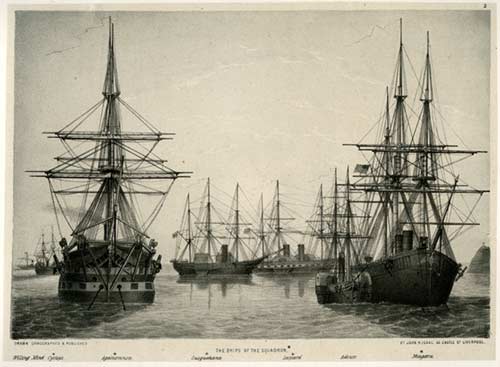
PLATE 2. THE SHIPS OF THE SQUADRON
Willing Mind Cyclops Agamemnon Susquehana Leopard Advice Niagara. |
| |
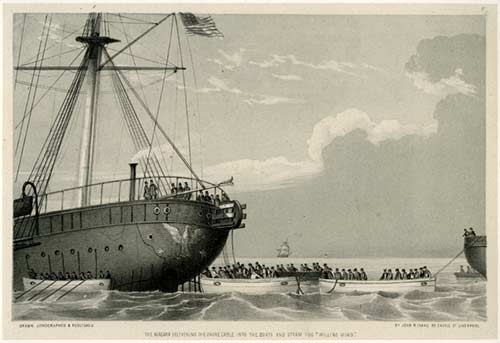
PLATE 3. THE NIAGARA DELIVERING THE
SHORE CABLE
INTO THE BOATS AND STEAM TUG “WILLING MIND” |
| |
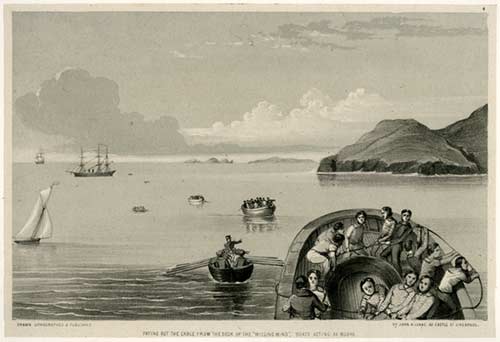
PLATE 4. PAYING OUT THE CABLE FROM
THE DECK
OF THE “WILLING MIND,” BOATS ACTING AS BUOYS |
| |

PLATE 5. THE “WILLING MIND”
AND BOATS WITH
CABLE, TOWED BY H.M. STEAMER “ADVICE” |
| |
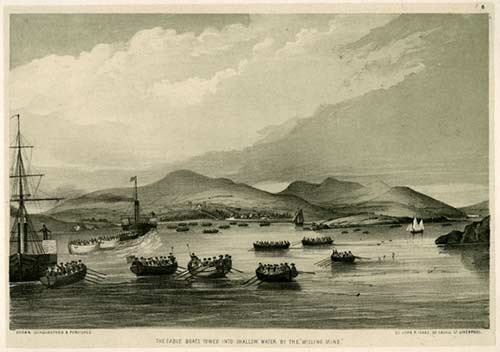
PLATE 6. THE CABLE BOATS TOWED INTO
SHALLOW WATER BY THE “WILLING MIND” |
| |
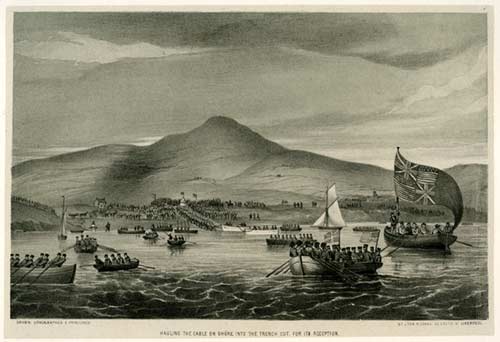
PLATE 7. HAULING THE CABLE ON SHORE
INTO THE TRENCH CUT FOR ITS RECEPTION |
| |
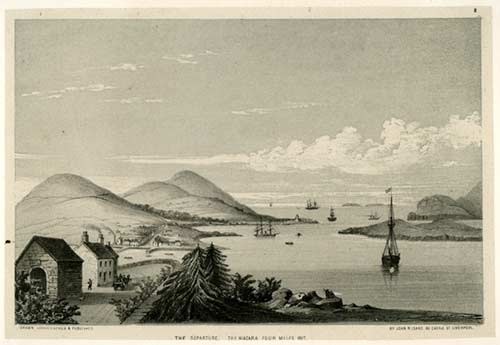
PLATE 8. DEPARTURE. THE NIAGARA FOUR
MILES OUT |
[1858
text]
As the Diaries of
Messrs. Bright and Field are extremely interesting, we think we cannot
present to our readers a more agreeable matter of information in connection
with the Atlantic Telegraph than a brief synopsis of each. We will take
that of Mr. C. T. Bright first. He commences by recording the departure
of the “Agamemnon” from Queenstown, at 2 p.m., on the 18th July [1858], and reaching the rendezvous on the night
of the 28th. On the morning of the 29th, the sea being smooth, the “Agamemnon”
and “Niagara” were connected by a hawser stern to stern, the
end of the cable on board the latter ship was then brought to the former
by the boats of the “Valorous” and “Agamemnon,” and
at one o’clock the splice was effected, the position of the ships being
lat. 52° 8’: long. 22° 27’W. [this is a typo in the original; the actual position was 32° 27’W. - see Cyrus Field’s notes below]; distance 938 2/10 statute or 815
nautical miles from the White Strand Bay, Valentia. After the cable was
dropped overboard the “Agamemnon” proceeded slowly, paying out
slack freely for the first three hours, after which the speed of the ship
increased to 4, and at 7 to 5 knots an hour. At 7-45 p.m., after passing
the cable from the outside to the centre of the coil in the main hold,
there was found an injury to the coil, it being squeezed between the side
of the curve in the eye of the coil and the end of the piece of wood by
which the leading-in part of the coil was defended. The injury having
been quickly repaired, during which operation Mr. Bright bears testimony
to the skill of his assistants, signals were again exchanged with the
“Niagara,” which had been temporarily suspended. At this time
46 nautical miles of cable had been payed out from the “Agamemnon.”
The depth of water at the time of this stoppage was 2,030 fathoms, on
the 30th at noon, 135 nautical miles had been payed out, being then in
lat. 52° 24’: long. 29° 50’ and 718 miles distant from Valentia.
At this period the “Niagara” reported that she had payed out
130 miles of cable. At midnight the wind was blowing hard, and so great
a consumption of coal took place, that it was feared, if the bad weather
continued, there might be an insufficiency in the supply of fuel. On the
31st at noon the “Agamemnon” had payed out 280 miles and the
“Niagara” 285 miles of cable. The dead reckoning made the position
of the “Agamemnon” at this period to be about 605 miles from
Valentia, and the depth of the ocean to be 2,400 fathoms, being the utmost
depth attained during the voyage. During the day the wind continued to
blow hard and the sea to run high. At midnight the barometer fell, and
there was every indication of severe weather; 358 miles of cable on this
day had been payed out, the “Niagara” signalling that she had
parted with 365 miles. On Sunday, August 1, the “Agamemnon”
was 478½ miles from Valentia, being in lat. 52° 26’ 30":
long. 23° 16’ 30”, 434 miles of coil having been payed out from
the “Agamemnon,” and 440 by the “Niagara.” The weather
after this gave some signs of amendment, but a heavy swell remained, and
the ship pitched much.
By noon on the 2nd
the “Agamemnon” was in lat. 52° 35’, long. 19° 48’,
351 1/6 miles from Valentia, 605 miles of cable having been laid from
the “Agamemnon,” and 615 from the “Niagara.” In the
Afternoon the wind went down considerably, making the motion of the ship
easier. At 3 p. m. the course of the ship had to be altered to avoid a
three-masted schooner. The weather in the evening was squally. At 4 the
next morning there appears to have been considerable excitement on board
in consequence of a barque bearing down upon the starboard beam of the
“Agamemnon.” She was, however, hove to on being intercepted
by the “Valorous.” On the 3rd August 776 miles of cable were
paid out, being then in lat. 52° 26’, long. 16° 7’ 40”, the
“Niagara” having laid 780 miles of cable. After this the depth
of water, which had averaged 2,000 fathoms since the 1st instant, began
to lessen. At 5 p.m. the greatest variation occurred, being from 1,750
fathoms to 550, within about ten miles. By midnight the depth had decreased
to 216 fathoms. At 4 a.m. of the 4th the large coil in the main hold was
paid out and a commencement of the coil upon the upper deck was made.
At noon the water deepened again to 400 fathoms. This was in lat. 52°
11’, long. 12° 40’, being then 89½ miles from Valentia, 924
miles of cable having been payed out. The “Niagara” had laid
925 miles. On approaching within 50 miles of Valentia the “Valorous”
steamed ahead to make out the land. The water now began shoaling rapidly.
At 8-30, the second coil having been finished, a change was effected to
the Orlop deck. At midnight the upper Skellig light was made; and at dawn
on the 5th the “Agamemnon” was abreast of the Blasquets, steaming
slowly towards Valentia. At 6 a.m. the “Agamemnon” was brought
to anchor in Doulas Bay, 2,026 nautical miles of cable having been payed
out between the two ships. At 3 p.m. of the 5th the end of the cable was
safely taken to the beach and passed into the station-house at Knightstown.
The strain on the
cable, Mr. Bright states, varied during the paying out under different
circumstances of weather, depth of water, and speed of ship. Some inconvenience
was experienced by the great accumulation of pitch and tar, but it was
found to be ultimately of great advantage, as preventing the cable from
running out too quickly. The amount of slack payed out amounted to 22
per cent. Mr. Bright bears strong testimony to the laborious zeal and
untiring patience exhibited by Captain Preedy and the officers of the
“Agamemnon;” and also his obligations to Messrs. Canning, Clifford,
Hoar and Moore, the engineers acting under his direction. He also favourably
mentions the exertions of Captain Hudson, and the officers of the “Niagara,”
and also of Messrs. Everett and Woodhouse, the engineers on board the
latter ship.
The following is from
Mr. CYRUS FIELD’S “Notes.”
Thursday, July 29. -Lat. 52° 59 N., long. 32° 27. Fleet in sight. Sea smooth.
Light wind. At 1 p.m. splice effected. Perfect signals passed between
the ships; depth of water 1,550 fathoms. Distance to Valentia Harbour
813 nautical miles, 827 nautical miles to Trinity, N.F., and from thence
to Telegraph House at head of bay, Bull Arm, 60 miles, making in all 882
miles. 1,100 miles of cable on board the “Niagara” and “Agamemnon.”
At 7 p.m. signals ceased, but at 11-30 p.m. perfect signals were again
received.
Friday, July 30.
-Lat. 51° N. Distance run in 23 hours 89 miles; payed out 131 miles,
900 fathoms over the distance run, equal to 48 per cent. Depth of water
1,550 to 1,970 fathoms. At 3-30 finished the maindeck coil and commenced
that from the berth-deck. The “Agamemnon” had payed out 150
miles. At 2-34 p.m. the “Niagara” had payed out 150 miles.
Saturday, July 31. -Distance run in the last 24 hours, 137 miles, payed out 159 miles:
853 fathoms of cable on a surplus of 22 miles; 843 fathoms over the distance
equal to 13 per cent. Depth of water 1,657 to 2,250 fathoms; weather cloudy;
a little rain and some sea. Total amount of cable payed out 201 miles
730 fathoms. Total distance run 236 miles; surplus cable payed out over
the distance, 65 miles 730 fathoms, equal to 29 per cent. At 11-4 p.m.
paid out from the “Niagara” 300 miles of cable. At 2-45 p.m.
received signals from the “Agamemnon” that they had payed out
her 300 miles; at 5-37 finished the coil on the berth-deck, and commenced
paying out from the lower deck.
Sunday, August 1. -Lat. 50° 32’ N., long. 41° 55’ W. Distance run during the
last 24 hours 145 miles; payed out 164 miles and 83 fathoms, as a surplus
of 19 miles 630 fathoms over the distance equal to 14 per cent. Depth
of water 1,950 to 2,424 fathoms; weather cloudy and misty, and heavy swell.
Total amount of cable payed out 456 miles 400 fathoms; total amount of
distance run by observation, 371 miles; total amount of surplus cable
payed out over distance run, 85 miles 600 fathoms, equal to 23 per cent.
At 3-5 p.m. finished the coil on the lower deck and changed coil to the
lower hold.
Monday, August 2. -Lat. 49° 52’ N., long. 45° 48’ W. Distance run in the last
24 hours 154 miles; payed out 177 miles 15 fathoms of cable or a surplus
of 23 miles 100 fathoms on the distance, equal to 15 per cent. Depth of
water 1,600 to 2,380 fathoms; “Niagara” getting light, rolled
very much. Total amount of cable payed out 633 miles 500 fathoms; total
distance run 525 miles; total surplus cable payed out over distance run
100 miles 500 fathoms, or less than 21 per cent. At 12-38 imperfect insulation
of the cable detected, which continued until 5-40 a.m. The fault was found
in the Ward-room or in about 60 miles from the lower end. Defective part
taken out of circuit.
Tuesday, August 3. -Lat. 45° 17’N., long. 49° 23’ W.[this is a typo in the original; the actual position was 49° 17’N.], distance run by observation
in the last 24 hours, 147 miles; payed out 162 miles 61 fathoms of cable,
or a surplus of 14 miles 613 fathoms over the distance run, equal to 10
per cent.; depth of water 742 to 1,827 fathoms; weather pleasant. Total
amount of cable payed out, 795 miles 300 fathoms. Total distance run,
672 miles. Total surplus cable payed out over the distance 123 miles 300
fathoms, less than 19 per cent. At 8-26 a.m. finished paying out the coil
from the hold and commenced paying out from the ward room, 305 miles remaining
on board at noon. At 11-15 a.m. ship’s time, received a message from the
“Agamemnon” that they had payed out 780 miles of cable. During
the afternoon and evening passed several icebergs. “Agamemnon”
signalled at 9-10 a.m. that she was in 200 fathoms of water. At 10-20
ship’s time, the “Niagara” was in 200 fathoms. Wednesday, 7
at night, lat. 48° 17’N., long. 52° 43’ W., distance run, 146
miles, payed out 154 miles, 160 fathoms of cable, or a surplus of 8 miles
360 fathoms over the distance run, equal to 6 percent; depth of waterless
than 200 fathoms. Weather fine and calm. Total amount of cable payed out
949 miles 660 fathoms. Total surplus cable over distance run 131 miles
660 fathoms, about 16 per cent. At noon received signals that the “Agamemnon”
had payed out her 940 miles of the cable; passed several icebergs; made
the land of Trinity bay at 8 a.m. Entered Trinity Bay at 12-30 p.m. At
2-20 p.m. ship’s time, stopped making signals. Recommenced signalling
at 2-40 p.m. At 7-30 piloted into Trinity Bay by H. M. steamer “Porcupine.”
Thursday, August 5. -1-45, the “Niagara” anchored. Distance run since previous
day 64 miles; amount of cable payed out, 66 miles 353 fathoms, being a
loss of less than 4 per cent. Total amount of cable payed out since the
splice was made, 1,016 miles 600 fathoms; total distance run 882 miles;
total amount of cable payed out over distance run 134 miles 600 fathoms,
being a surplus of about 15 per cent. At 2 a.m. went ashore, informed
the people at the telegraph house that the cable was ready for landing.
At 2-45 received signal from the “Agamemnon” that she had payed
out 1,010 miles of cable. At 5-15 a.m. The Telegraph Cable was landed.
At 6 a.m. the shore end of the cable was carried to the Telegraph House
and a strong current of electricity was received from the other side of
the Atlantic. Captain Hudson received messages at 11 a.m. H. M. steamer
fired a salute of 21 guns.
One fact worth recording
above all others shows strongly the importance of the work. This may be
seen by the first message sent through the wires from America to England,
which was that conveying the information of the collision between the
“Europa” and “Arabia,” the effect of which would be
to allay all popular alarm that must have been felt by the detention of
the “Europa.” Had that information not been received £50,000
at least would have been expended in insurance owing to the delay in the
arrival of the vessel.
We conclude this
brief account of the Telegraph Cable by appending the message from Her
Majesty Queen Victoria to the President of the United States, and his
reply.
| THE QUEEN TO THE
PRESIDENT. |
“The Queen desires
to congratulate the President upon the successful completion of this great
international work, in which the Queen has taken the deepest interest.
The Queen is convinced that the President will join with her in fervently
hoping that the electric cable, which now connects Great Britain with
the United States, will prove an additional link between the two places
whose friendship is founded upon their common interests and reciprocal
esteem. The Queen has much pleasure in thus directly communicating with
the President, and in renewing to him her best wishes for the prosperity
of the United States.”
|
| |
| THE PRESIDENT TO
THE QUEEN. |
“WASHINGTON CITY.
|
“To Her Majesty
Victoria Queen of Great Britain. –The President cordially reciprocates
the congratulations of her Majesty the Queen on the success of the great
international enterprise, accomplished by the skill, science, and indomitable
energy of the two countries. It is a triumph more glorious, because far
more useful to mankind, than was ever won by conqueror on the field of
battle. May the Atlantic Telegraph, under the blessing of Heaven, prove
to be a bond of perpetual peace and friendship between the kindred nations,
and an instrument destined by Divine Providence to diffuse religion, civilization,
liberty, and law throughout the world.
“In this view
will not all nations of Christendom spontaneously unite in the declaration
that it shall be for ever neutral, and that its communications shall be
held sacred in passing to the places of their destination, even in the
midst of hostilities.
|
| (Signed) |
“JAMES BUCHANAN.”
|
John Raphael Isaac (1808-1870)
by James Dickie
John Raphael Isaac was the eldest son of Ralph and Sophia Isaac (m.1805). In 1839, he married Sarah Amelia Coleman (1813-1901), granddaughter of Rabbi Benjamin Yates (d.1798) and ancestor of Viscount Samuel. The marriage was solemnised at Seel Street Synagogue, where Isaac subsequently held the post of Junior Treasurer, 1841-43. His in-laws were engravers like himself and his wife’s uncle engraved over 30 bookplates.
Isaac designed the menu for Prince Albert’s reception at the Town Hall in 1846, and was appointed medallist to the Prince. His advertisement reads, under the royal coat of arms, “By special appointment to HRH Prince Albert,” and goes on to list his specialities as “Drawing Designs and Plans, Armorial Painting and Manuscript Illumination,” with each line in a different script to show his versatility as a calligrapher.
Isaac worked in various media but especially lithography. He was also an art dealer and ran a heraldic office, engraving seals and bookplates. Seven signed bookplates dated between 1840 and 1860 are recorded. His trade card supplies further particulars: “Publisher, Printseller, Carver, Gilder and Picture Frame Manufacturer.” His business was located at 37 Castle Street in 1839 but, from 1843-67, he operated from the Art-Union Rooms at 62 Castle Street. He held the office of Honorary Secretary for Liverpool of the Art-Union, London. He subsequently operated from other addresses. He opened a lithographic studio in 1850.
Isaac resided at several addresses, notably numbers 27 and 46 Bedford Street North, both now victims of university expansion. He did work for the Royal Steamship Co, and published lithographs of the laying of the North Atlantic Cable, which could be bought either tinted or hand-coloured. In 1850, he issued a lithograph of the new synagogue in Hope Place, as well as a panorama of Liverpool seen from a balloon. A scrapbook in the Liverpool Record Office contains designs for memorials both Jewish and Christian, equine subjects, gentlemen’s seats, and rural churches.
Besides topographical work, he was a ship portraitist, producing prints of Liverpool shipping. As well as lithographing his own work, Isaac lithographed that of other artists, such as Samuel Walters, Liverpool’s most famous marine artist. The five prints after Walters include the Royal Charter (1856), published from 62 Castle Street. Another print is of a captured slaver, the Ashburton, in addition to lithographic portraits of tea clippers on the Liverpool register Crest of the Wave (1853), Spray of the Ocean (1854). Both ships were owned by Brice, Friend & Co, by whom he was commissioned to portray vessels in their fleet, but by far his best known work in this genre is his lithograph of the famous emigrant ship, the Lightning, which was plagiarised for a music cover (score by the Victorian music-hall artiste, Charles d’Albert). The ship was captained by “Bully” Forbes, whose tomb is in Toxteth Park Cemetery. Isaac also did commercial work for the Holt Shipping Line and the White-Star (Packet) Line (Liverpool-Melbourne). These commissions from major shipping companies explain how Isaac’s son Percy became a naval architect and shipbuilder.
Links
http://www.jewishencyclopedia.com/view.jsp?artid=205&letter=S
http://www.jewishencyclopedia.com/view.jsp?artid=25&letter=Y
Other Sources
Wolf, L (1901) “History and Genealogy of the Jewish Families of Yates and Samuel of Liverpool”, London. No ISBN.
Grave References
John Raphael Isaac (1808-1870): 273A Row 9
Sarah Amelia Isaac (née Yates; his wife 1813-1901): 744A Row 26
John R. Isaac biography copyright © 2006 James R. Dickie. Used by permission. |
Return to the Atlantic Cables index page |

